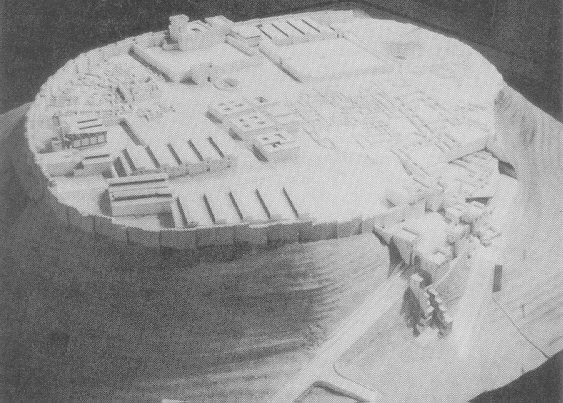The Case Of Meggido -- By: David G. Hansen
Journal: Bible and Spade (Second Run)
Volume: BSPADE 04:3 (Summer 1991)
Article: The Case Of Meggido
Author: David G. Hansen
BSP 4:3 (Summer 1991) p. 84
The Case Of Meggido
UNDERSTANDING THE IMPORTANCE OF GEOGRAPHY IN BIBLICAL STUDY

Scale model of Meggido (in the Meggido museum) from about the time of Ahab.
Megiddo! An important city for all of recorded history. The very name elicits excitement. Writers like Michener, who used Megiddo as a model for his fictional Tell Makor in The Source, and Bible scholars have been captivated by the events which comprise its long and colorful past.
Megiddo’s importance as a future battleground is inferred in the New Testament: Armageddon is the place of God’s final victory over the forces of the world (Rev 16:16). And, for readers of this magazine, Megiddo offers an excellent example of the geographic influences in the establishment of ancient cities.
Since earliest times, people with mutual commercial or agricultural interests have searched for naturally occurring defensive locations where they could safely pursue their enterprises. Towns were constructed to protect the inhabitants from unfriendly
BSP 4:3 (Summer 1991) p. 85
friendly neighbors and marauding armies. Considerations which prompted the early settlers to select town sites have not changed over the centuries and many of the most favorable locations grew to great size. Megiddo is one such place and it attests that “What has been will be again, what has been done will be done again; there is nothing new under the sun.” [Eccl 1:9 (NIV)]
Unlike many ancient cities, much of Megiddo’s history is known. Thus, Megiddo makes an excellent case study of the military significance of cities in the Bible. Its revealed history is so exhaustive that we know Megiddo was the target of one of the first recorded campaigns by a military conqueror. A tomb inscription from the Early Bronze Age describes how an Egyptian general, Weni, a commander under the Pharaoh Pepi I (ca 2325–2275 BC), invaded the area in which Megiddo lies. Weni’s tomb inscription describes how he found fortified towns, excellent vineyards and fine orchards. Weni campaigned at least four more times around Megiddo and put down “insurrections” there, probably local farmers chafing under the oppressive Egyptian rule.1
In succeeding centuries, Megiddo continued to attract Egyptian military operations. It is the site of the world’s earliest battle for which any detailed record exists. A well-preserved bat...
Click here to subscribe
